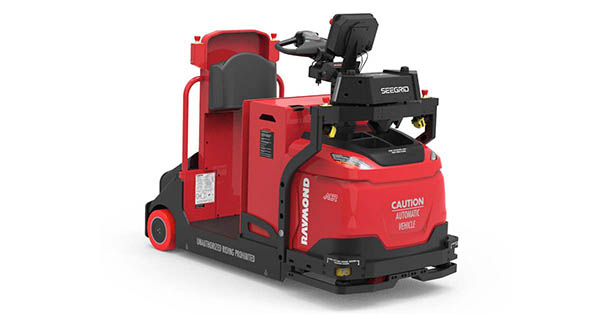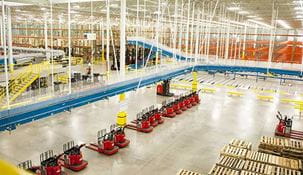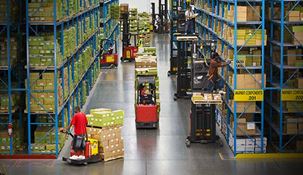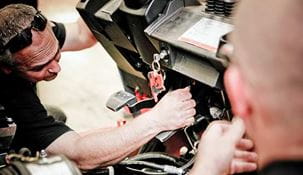-

Greenville Autonomous Guided Vehicle (AGV)
Carolina Handling sells, installs and maintains Autonomous Guided Vehicles (AGVs) and other AS/RS equipment in South Carolina and across the Southeast. Our automation specialists can help you find the perfect solution from world class AS/RS manufacturers like Modula.
South Carolina Autonomous Guided Vehicle Supplier
What is an AGV?
Oftentimes known as self-guided vehicles or automatic guided vehicles, automated guided vehicles (AGVs) are material handling systems or load carriers that proceed autonomously across the floors of a warehouse, DC or production facility without an onboard driver.
What are Automated Guided Vehicles used for?
Standard AGV applications include retrieval and storage in warehouses and distribution centers, usually in support of order picking. They are additionally used for transportation of raw materials, work-in-process and finished goods in manufacturing centers.
What are a few of the primary advantages of Self-Guided Vehicles?
- Decreased Labor Costs: AGVs can substantially decrease labor costs. A one-time expenditure can get rid of the continuous costs of salaries, taxes and benefits connected with a full-time worker.
- Increased Safety: Contemporary AGVs utilize sophisticated video cameras, lasers or other sensors that permit them to "see" and respond to their surroundings at lightning speed. Humans can get tired or distracted, whereas machines do not. AGVs can likewise be used in extreme conditions or around hazardous materials where personal safety is jeopardized.
- Increased Productivity & Accuracy: AGVs can work around the clock, never requiring breaks or getting fatigued. They can make distant treks around a warehouse quickly. They likewise do not make the types of mistakes that humans are prone to making.
- Modularity: Most AGV solutions can be put into place gradually, displacing a few employees incrementally without an enormous expenditure in advance. As automation requirements increase, more AGVs can quickly be introduced to the facility.
How do AGVs work?
AGVs are shepherded by a mix of sensor-based guidance systems and bundled software. They can maneuver securely through a storage or production facility by using barrier detection bumpers and following thoroughly defined paths while utilizing precisely managed acceleration and deceleration.
AGV navigation is usually managed by one of these categories of systems:
- Vision guidance: Cameras log the AGV's surroundings, and the vehicles use these cataloged videos to navigate. Vision guidance is standalone, meaning no adjustment is needed to a production facility or warehouse infrastructure for this kind of navigation.
- Laser target navigation: With laser-based equipment, reflective tape is attached to pallet racks, wall surfaces, poles and other fixed bodies. AGVs use laser transmitters to bounce light off of these reflectors and then utilize the proximity and angle of items to maneuver.
- LiDAR: LiDAR solutions send laser pulses to measure the distance around the AGV and objects in its environment. This information is utilized to establish a 360-degree map of the surroundings. Like vision guidance, no adjustment of a facility is required.
- Inertial navigation: Transponders embedded into a building's floor guide AGVs along a defined track.
- Wired navigation: These systems utilize wire paths embedded into a warehouse or factory floor. The wire transmits a signal that an AGV detects by means of a sensing unit or antenna system.
- Magnetic guide tape: This kind of AGV makes use of magnetic sensors and conforms to a path laid out by magnetic tape.
What are the different types of Autonomous Guided Vehicles?
There are a number of kinds of automated guided vehicles. Many AGVs are similar to other human-operated vehicles but are developed to operate with no direct human supervision or guidance.
- Forklift AGVs: Forklift automatic guided vehicles are a frequently utilized type of AGV in warehouses. They're engineered to transport pallets without the assistance of a human operator.
- Automated Guided Carts: An automated guided cart is probably the most fundamental type of AGV. They can transport all kinds of materials from entire pallets to small parts. AGCs are frequently utilized in storage, sorting and cross-docking applications.
- Tugger AGVs: Towing or "tugger" AGVs pull unpowered, load-carrying carts trailing them in a train-like setup. These kinds of automatic guided vehicles are often used for transferring heavy loads over long distances. Sometimes they are programmed to make multiple drop-offs and pickups along their path.
- Unit Load Handlers: Unit load handlers ferry singular payloads like specific items or a discrete pallet or tote.
- Heavy Burden Carriers: These are utilized for extremely heavy loads like castings, coils or plates.
Automated Guided Vehicle Supplier Near Me
If you'd like a full analysis of AGV opportunities for your warehouse, DC or manufacturing center, you can consult with an expert at Carolina Handling.
-
-
Proudly serving
Greenville, Simpsonville,
Easley, Greer, Spartanburg,
Gaffney, Clemson, Anderson,
Greenwood, Rock Hill, Lancaster,
Fort Mill, Newberry,
Piedmont, Mauldin,
and the entire State of South Carolina.
You May Also Like:

Automation
Carolina Handling can help you automate every aspect of your warehouse operation to increase efficiency.
Learn More

Optimization
Optimize everything in your warehouse to improve productivity and reduce operating costs.
Learn More

Warehouse Products
Looking for the right product for your operation? We have everything you need to do business in stock.
Learn More

Service Maintenance
Providing superior lift truck service and maintenance for our customers is Carolina Handling's highest priority.
Learn More


